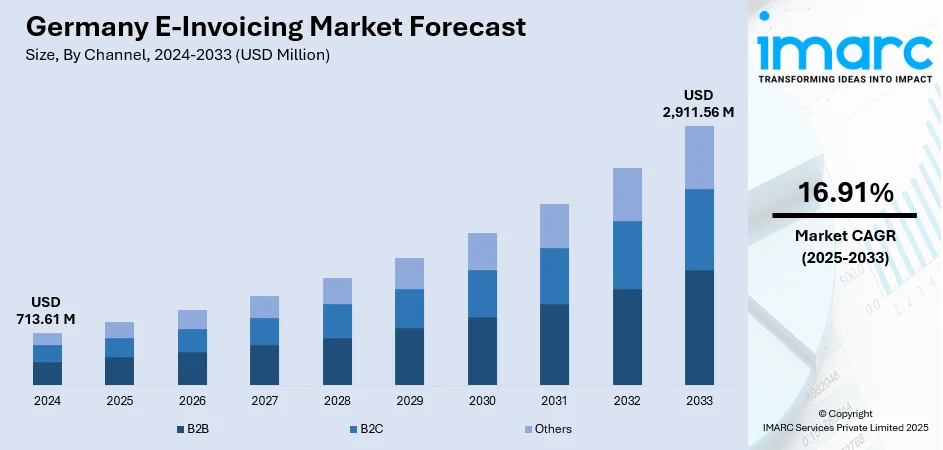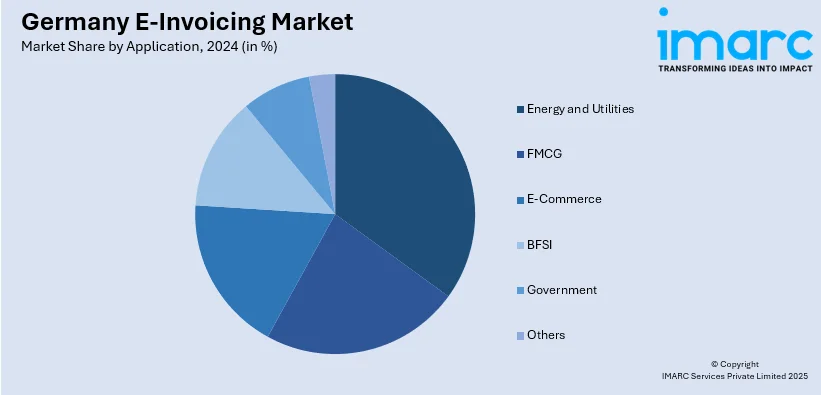
Germany E-Invoicing Market Size, Share, Trends and Forecast by Channel, Deployment Type, Application, and Region, 2025-2033
Germany E-Invoicing Market Overview:
The Germany e-invoicing market size reached USD 713.61 Million in 2024. Looking forward, the market is expected to reach USD 2,911.56 Million by 2033, exhibiting a growth rate (CAGR) of 16.91% during 2025-2033. The market is fueled by stringent regulatory requirements, starting with B2G compliance and extending to B2B invoices under the Growth Opportunities Act. Use of standardized formats such as XRechnung and ZUGFeRD facilitates EU norms compliance while facilitating seamless integration with public procurement systems. Government stimulus, VAT fraud prevention, and increasing need for process automation also drive adoption. Interoperability via Peppol and pressure for digital transformation from various industries further foster mass adoption, contributing to a sizeable increase in the Germany e-invoicing market share across industries.
|
Report Attribute
|
Key Statistics
|
|---|---|
|
Base Year
|
2024
|
|
Forecast Years
|
2025-2033
|
|
Historical Years
|
2019-2024
|
| Market Size in 2024 | USD 713.61 Million |
| Market Forecast in 2033 | USD 2,911.56 Million |
| Market Growth Rate 2025-2033 | 16.91% |
Germany E-Invoicing Market Trends:
Standardization and Regulatory-driven Expansion
Germany has experienced revolutionary change with its phased implementation of compulsory e-invoicing regulations. At federal level, B2G invoicing since late 2020 has gone to XRechnung format, and most states have conformed—rendering structured XML invoices compulsory in public procurement settings. Later legislation under the Growth Opportunities Act (Wachstumschancengesetz) builds on this to B2B transactions: while the full mandate is from 2028, a step-by-step approach began in 2025 for bigger companies and rolls out by sector and size. The regulatory adjustments make Germany a leader in Europe, with well-defined national formats and timelines shaping take-up. The government initiative guarantees robust incentives for compliance and a consistent e-invoicing environment for both the public and private sectors.

To get more information on this market, Request Sample
Format Interoperability and Technological Integration
Germany's standards—XRechnung for strict XML invoicing and hybrid ZUGFeRD format—are entirely compatible with EU standards and encouraged by organizations such as FeRD. ZUGFeRD 2.3 and its counterpart Factur-X promote B2B and B2G communication by placing machine-readable XML inside human-readable PDFs and provide flexibility with backward compatibility. Interoperability is also promoted through Peppol, which is used extensively across federal and state portals to route invoices in a seamless way. Concepts like AI-based validation and ERP integrations also make things more contemporary, aiding in automation and eliminating manual errors. With the progress of digital solutions, Germany's strategy combines strict adherence to standards with plug-and-play hybrid models to ease the transition for companies of every size, which further contributes to the Germany e-invoicing market growth.
Adoption Challenges and SME Readiness
While e-invoice exchange volumes have grown very quickly, early post-mandate volumes have also topped expectations. High rejection levels from inappropriate or incomplete invoice formats, legacy tools, and uncertainty from multiple format choices have been observed. For smaller enterprises in particular, the decision between XRechnung, ZUGFeRD, and PDF hybrids creates pragmatic challenges. Additional technical assistance, automated validation tools, and focused training are necessary to ensure that SMEs incorporate compliant e-invoicing, update ERP systems, and set standard checks. Trade bodies such as FeRD and software communities promote this transition actively. Action on these adoption dynamics is crucial for securing the momentum fueled by mandates into the larger SME segment beyond the big companies. Germany's e-invoicing market trends indicate a well-programmed regulatory rollout, strong technical standard alignment to EU standards, and sustained industry action to bridge practical adoption hurdles—especially for smaller companies—setting the stage for digital invoicing transformation.
Germany E-Invoicing Market Segmentation:
IMARC Group provides an analysis of the key trends in each segment of the market, along with forecasts at the country and regional levels for 2025-2033. Our report has categorized the market based on channel, deployment type, and application.
Channel Insights:
- B2B
- B2C
- Others
The report has provided a detailed breakup and analysis of the market based on the channel. This includes B2B, B2C, and others.
Deployment Type Insights:
- Cloud-based
- On-premises
The report has provided a detailed breakup and analysis of the market based on the deployment type. This includes cloud-based and on-premises.
Application Insights:

- Energy and Utilities
- FMCG
- E-Commerce
- BFSI
- Government
- Others
A detailed breakup and analysis of the market based on the application has also been provided in the report. This includes energy and utilities, FMCG, e-commerce, BFSI, government, and others.
Regional Insights:
- Western Germany
- Southern Germany
- Eastern Germany
- Northern Germany
The report has also provided a comprehensive analysis of all the major regional markets, which include Western Germany, Southern Germany, Eastern Germany, and Northern Germany.
Competitive Landscape:
The market research report has also provided a comprehensive analysis of the competitive landscape. Competitive analysis such as market structure, key player positioning, top winning strategies, competitive dashboard, and company evaluation quadrant has been covered in the report. Also, detailed profiles of all major companies have been provided.
Germany E-Invoicing Market News:
- In May 2025, new versions of the synchronized German ZUGFeRD 2.3 and French Factur-X1.07 e-invoicing standards were published on May 7. The completely aligned version of Factur-X, which was updated and released as Factur-X 1.07.3 and ZUGFeRD 2.3.3, respectively, complies with EU EN16931, which is the standard for EU VAT in the Digital Age e-invoicing 2030.
Germany E-Invoicing Market Report Coverage:
| Report Features | Details |
|---|---|
| Base Year of the Analysis | 2024 |
| Historical Period | 2019-2024 |
| Forecast Period | 2025-2033 |
| Units | Million USD |
| Scope of the Report |
Exploration of Historical Trends and Market Outlook, Industry Catalysts and Challenges, Segment-Wise Historical and Future Market Assessment:
|
| Channels Covered | B2B, B2C, Others |
| Deployment Types Covered | Cloud-based, On-premises |
| Applications Covered | Energy and Utilities, FMCG, E-Commerce, BFSI, Government, Others |
| Regions Covered | Western Germany, Southern Germany, Eastern Germany, Northern Germany |
| Customization Scope | 10% Free Customization |
| Post-Sale Analyst Support | 10-12 Weeks |
| Delivery Format | PDF and Excel through Email (We can also provide the editable version of the report in PPT/Word format on special request) |
Key Questions Answered in This Report:
- How has the Germany e-invoicing market performed so far and how will it perform in the coming years?
- What is the breakup of the Germany e-invoicing market on the basis of channel?
- What is the breakup of the Germany e-invoicing market on the basis of deployment type?
- What is the breakup of the Germany e-invoicing market on the basis of application?
- What is the breakup of the Germany e-invoicing market on the basis of region?
- What are the various stages in the value chain of the Germany e-invoicing market?
- What are the key driving factors and challenges in the Germany e-invoicing market?
- What is the structure of the Germany e-invoicing market and who are the key players?
- What is the degree of competition in the Germany e-invoicing market?
Key Benefits for Stakeholders:
- IMARC’s industry report offers a comprehensive quantitative analysis of various market segments, historical and current market trends, market forecasts, and dynamics of the Germany e-invoicing market from 2019-2033.
- The research report provides the latest information on the market drivers, challenges, and opportunities in the Germany e-invoicing market.
- Porter's five forces analysis assist stakeholders in assessing the impact of new entrants, competitive rivalry, supplier power, buyer power, and the threat of substitution. It helps stakeholders to analyze the level of competition within the Germany e-invoicing industry and its attractiveness.
- Competitive landscape allows stakeholders to understand their competitive environment and provides an insight into the current positions of key players in the market.
Need more help?
- Speak to our experienced analysts for insights on the current market scenarios.
- Include additional segments and countries to customize the report as per your requirement.
- Gain an unparalleled competitive advantage in your domain by understanding how to utilize the report and positively impacting your operations and revenue.
- For further assistance, please connect with our analysts.
 Request Customization
Request Customization
 Speak to an Analyst
Speak to an Analyst
 Request Brochure
Request Brochure
 Inquire Before Buying
Inquire Before Buying




.webp)




.webp)












